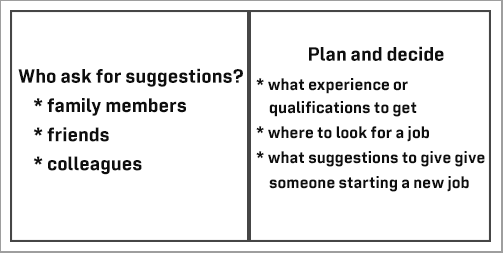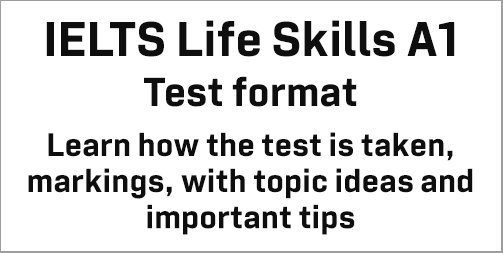IELTS Life Skills B1 – Test format, markings/ results, topic ideas and tips
This post focuses on the test format of the IELTS Life Skills B1 test format. This test is comparatively difficult to A1 test. The post helps you understand what’s in the test or how the test is taken step-by-step. This post will also help you take preparation for the different topics that are required to learn by any candidate anywhere in the world.
IELTS Life Skills B1 is a speaking and listening test, which is available at A1 and B1 levels. This particular test is essential to support an application to live in the UK. The tasks in the test are designed in a way that reflects the experience of communicating in a country where English is the main language of communication.
Unlike many other tests, two candidates (Candidate A & Candidate B) take this particular test together as they are interviewed by one examiner.
Markings/ Results for IELTS Life Skills tests:
Test results are normally available within seven days of the test.
Candidates will get one of two results:
- Pass
- Fail
A fail result means that candidates have not been successful and the test cannot be used for the visa application.
The test format:
The IELTS Life Skills B1 consists of four parts, which are known as ‘phases’.
Phase 1a (3 minutes):
- The examiner asks Candidate A and Candidate B their names and nationalities.
- Then, the examiner gives both candidates a topic, such as food, free time, friends, etc. to ask each other about. Both candidates ask each other questions and give answers to the questions for about 2 minutes.
- The examiner might ask both candidates a few questions, but this happens only when the candidates stop talking.
Phase 1b (7 minutes):
- The examiner gives the candidates two different topics. For instance, he/she may give Candidate A the topic ‘Your school life’ and give Candidate B the topic ‘Your favourite food’.
- Here, each candidate gets 1 minute to prepare a small talk/speech on the topic.
- First, Candidate A talks for about 1 and a half minute on the topic ‘Your school life’ while Candidate B listens to the talk. Then, when Candidate A stops talking, Candidate B asks Candidate A three questions about the topic. Candidate A answers the questions.
- Next, Candidate B talks for about 1 and a half minute on the topic ‘Your favourite food’ while Candidate A listens to the talk. Then, when Candidate B stops talking, Candidate A asks Candidate B three questions about the topic. Candidate B answers the questions.
Phase 2a (5 minutes):
- Both candidates listen to Recording 1 and Recording 2 on a CD player.
- The examiner shows a visual material and asks Candidate A one question from Recording 1 and asks Candidate B one question from Recording 2. Both candidates answer the questions by selecting the correct visual material.
- Both candidates listen to Recording 1 and Recording 2 one more time.
- Now, the examiner asks both candidates two more questions. This time, the examiner asks Candidate B two questions from Recording 1 and asks Candidate A two questions from Recording 2. Both candidates respond to the questions.
Phase 2b (7 minutes):
This phase has two parts:
- In the first part, the examiner asks the candidates to plan and decide something together. For instance, the candidates may be asked to imagine a situation (such as a friend trying to decide on his future job and needs suggestions) and discuss what a friend or colleague should do.
- The examiner gives both candidates a list of suggestions for things to talk about, and reads out the list.
- Both candidates talk for 2 minutes. Candidates choose an option from the list on the left, and then plan and decide what to do about it using the ideas on the right. Here’s an example of it:

- In the second part, the examiner asks both candidates to discuss a topic (such as, getting information/starting a new course). This part is usually connected to the plan the candidates talked about in the first part.
- Both candidates talk with each other on the topic. If they stop too early, the examiner asks them a few questions to continue the talk.
That’s how the test goes.
Here are some common topics which are the focus of IELTS Life Skills Test:
- Information about candidates and their life
- Family and friends
- Hobby
- Buying things
- Work
- Health
- Food
- Free-time activities
- Education
- Learning new things for work
- Transport
- Exercise
- House / home
- Weather
Important tips for the test:
- Make sure you know how to spell your name.
- Try to speak clearly with a clear voice. This way the examiner can hear you easily.
- Don’t try to use any word or grammar that you have no idea about.
- When asking questions, if you don’t understand your partner candidate, say ‘I’m sorry I don’t understand’ or, ‘Can you repeat that, please?’
- Try to use Wh-words like what, when, where, who, etc. in your questions.
- You can also use question words such as do/does to ask questions.
- Avoid answering questions with ‘Yes’ and ‘No’ only.
- If you don’t understand the examiner’s questions, ask him/her to repeat the questions.
- Try to take some notes if the examiner allows you time. Use your own way or language to take notes (notes are not part of the test).
- If you have problems understanding a long question, give importance to the keywords; you don’t need to understand every word.
- When the other candidate speaks, give him/her some time to finish; don’t interrupt them.
- If you feel nervous in the test, take your time. Slow yourself. Don’t talk too quickly; you can give pause between sentences. This helps you overcome nervousness.
- If you want to say a word, but you can’t remember the word instantly; describe the word with other words. For example, suppose you want to say the word ‘enjoyable’ but you can’t remember it, you can explain it with other words like ‘a matter of great pleasure’.
- Use contracted forms like ‘I’m’, ‘don’t’, ‘shouldn’t’ etc. instead of ‘I am’, ‘do not’, ‘should not’ etc.
- If you don’t know professional or native English, it doesn’t matter. The purpose of the test is to judge your basic communication skills. So, don’t worry too much.
Good luck with your exam.




Very good post…
Its too good for my practice
Nice article, very informative. Great Post! All the points and steps are very clearly explained.
Brilliant tips ?